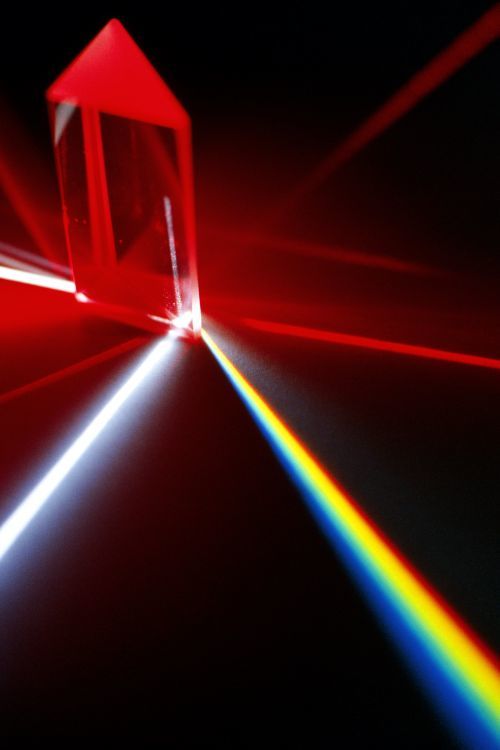Refraction is the bending of light (it also happens with sound, water and other waves) as it passes from one transparent substance into another.
This bending by refraction makes it possible for us to have lenses, magnifying glasses, prisms and rainbows. Even our eyes depend upon this bending of light. Without refraction, we wouldn’t be able to focus light onto our retina.
Change of speed causes change of direction
Light refracts whenever it travels at an angle into a substance with a different refractive index (optical density).
This change of direction is caused by a change in speed. For example, when light travels from air into water, it slows down, causing it to continue to travel at a different angle or direction.
How much does light bend?
The amount of bending depends on two things:
- Change in speed – if a substance causes the light to speed up or slow down more, it will refract (bend) more.
- Angle of the incident ray – if the light is entering the substance at a greater angle, the amount of refraction will also be more noticeable. On the other hand, if the light is entering the new substance from straight on (at 90° to the surface), the light will still slow down, but it won’t change direction at all.
Refractive index of some transparent substances
| Substance | Refractive index | Speed of light in substance | Angle of refraction if |
| Air | 1.00 | 300 | 20 |
| Water | 1.33 | 226 | 14.9 |
| Glass | 1.5 | 200 | 13.2 |
| Diamond | 2.4 | 125 | 8.2 |
All angles are measured from an imaginary line drawn at 90° to the surface of the two substances This line is drawn as a dotted line and is called the normal.
If light enters any substance with a higher refractive index (such as from air into glass) it slows down. The light bends towards the normal line.
If light travels enters into a substance with a lower refractive index (such as from water into air) it speeds up. The light bends away from the normal line.
A higher refractive index shows that light will slow down and change direction more as it enters the substance.
Lenses
A lens is simply a curved block of glass or plastic. There are two kinds of lens.
A biconvex lens is thicker at the middle than it is at the edges. This is the kind of lens used for a magnifying glass. Parallel rays of light can be focused in to a focal point. A biconvex lens is called a converging lens.
A biconcave lens curves is thinner at the middle than it is at the edges. Light rays refract outwards (spread apart) as they enter the lens and again as they leave.
Refraction can create a spectrum
Isaac Newton performed a famous experiment using a triangular block of glass called a prism. He used sunlight shining in through his window to create a spectrum of colours on the opposite side of his room.
This experiment showed that white light is actually made of all the colours of the rainbow. These seven colours are remembered by the acronym ROY G BIV – red, orange, yellow, green, blue, indigo and violet.
Newton showed that each of these colours cannot be turned into other colours. He also showed that they can be recombined to make white light again.
The explanation for the colours separating out is that the light is made of waves. Red light has a longer wavelength than violet light. The refractive index for red light in glass is slightly different than for violet light. Violet light slows down even more than red light, so it is refracted at a slightly greater angle.
The refractive index of red light in glass is 1.513. The refractive index of violet light is 1.532. This slight difference is enough for the shorter wavelengths of light to be refracted more.
Rainbows
A rainbow is caused because each colour refracts at slightly different angles as it enters, reflects off the inside and then leaves each tiny drop of rain.
A rainbow is easy to create using a spray bottle and the sunshine. The centre of the circle of the rainbow will always be the shadow of your head on the ground.
The secondary rainbow that can sometimes be seen is caused by each ray of light reflecting twice on the inside of each droplet before it leaves. This second reflection causes the colours on the secondary rainbow to be reversed. Red is at the top for the primary rainbow, but in the secondary rainbow, red is at the bottom.
Activity ideas
Use these activities with your students to explore refration further:
- Investigating refraction and spearfishing – students aim spears at a model of a fish in a container of water. When they move their spears towards the fish, they miss!
- Angle of refraction calculator challenge – students choose two types of transparent substance. They then enter the angle of the incident ray in the spreadsheet calculator, and the angle of the refracted ray is calculated for them.
- Light and sight: true or false? – students participate in an interactive ‘true or false’ activity that highlights common alternative conceptions about light and sight. This activity can be done individually, in pairs or as a whole class.
Useful links
Learn more about different types of rainbows, how they are made and other atmospheric optical phenomena with this MetService blog and Science Kids post.
Learn more about human lenses, optics, photoreceptors and neural pathways that enable vision through this tutorial from Biology Online.




